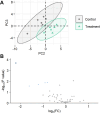An integrated multi-omics analysis of the effects of the food processing-induced contaminant 2-monochloropropane-1,3-diol (2-MCPD) in rat heart
- PMID: 39316134
- PMCID: PMC11496350
- DOI: 10.1007/s00204-024-03856-6
An integrated multi-omics analysis of the effects of the food processing-induced contaminant 2-monochloropropane-1,3-diol (2-MCPD) in rat heart
Abstract
Many foods including edible oils contain 2-monochloropropane-1,3-diol (2-MCPD), a processing-induced chemical contaminant. Cardiotoxic effects have been shown to result from oral 2-MCPD exposure in rodents, but the underlying mechanisms of action remain poorly understood. We undertook a comprehensive multi-omics approach to assess changes at the transcriptomic, proteomic, and oxylipin levels in heart tissues from male F344 rats that were exposed to 0 or 40 mg/kg BW/day of 2-MCPD in the diet for 90 days, in a regulatory compliant rodent bioassay. Heart tissues were collected for RNA sequencing, quantitative PCR analysis, proteomic analysis via two-dimensional gel electrophoresis and mass spectrometry, and targeted lipidomic profiling by high-performance liquid chromatography-tandem mass spectrometry (HPLC-MS/MS). Transcriptomic and proteomic data analyses revealed upregulation of immune/inflammatory response processes and downregulation of energy metabolism and cardiac structure and functions. Among differentially expressed gene-protein pairs, coronin-1A, a key leukocyte-regulating protein, emerged as markedly up-regulated. Oxylipin profiling highlighted a selective suppression of docosahexaenoic acid-derived metabolites, suggesting a disruption in cardioprotective lipid pathways. These findings suggest that 2-MCPD disrupts homeostasis through inflammatory activation and suppression of metabolic and cardiac function. This research provides insights into 2-MCPD's cardiotoxicity, emphasizing the need for further studies to support hazard characterization.
Keywords: 2-MCPD; Cardiotoxicity; Multi-omics; Oxylipin; Proteome; Transcriptome.
© 2024. Crown.
Conflict of interest statement
The authors have no conflicting interests to declare.
Figures






Similar articles
-
Bioactive lipids are altered in the heart, kidney, and serum of male and female F344 rats sub-chronically exposed to dietary 2-MCPD.Food Chem Toxicol. 2024 Nov;193:115004. doi: 10.1016/j.fct.2024.115004. Epub 2024 Sep 14. Food Chem Toxicol. 2024. PMID: 39284412
-
Cardiac oxylipin perturbances in response to 2-monochloropropane-1,3-diol exposure are ameliorated by dietary adequacy of the essential n-3 fatty acid, α-linolenic acid.Food Chem Toxicol. 2024 Dec;194:115080. doi: 10.1016/j.fct.2024.115080. Epub 2024 Nov 2. Food Chem Toxicol. 2024. PMID: 39491768
-
Nephrotoxicity evaluation of 3-monochloropropane-1,2-diol exposure in Sprague-Dawley rats using data-independent acquisition-based quantitative proteomics analysis.Toxicol Lett. 2022 Mar 1;356:110-120. doi: 10.1016/j.toxlet.2021.12.008. Epub 2021 Dec 13. Toxicol Lett. 2022. PMID: 34915118
-
3-MCPD: A Worldwide Problem of Food Chemistry.Crit Rev Food Sci Nutr. 2016 Oct 25;56(14):2268-77. doi: 10.1080/10408398.2013.829414. Crit Rev Food Sci Nutr. 2016. PMID: 25830907 Review.
-
Fatty Acid Esters of 3-Monochloropropanediol: A Review.Annu Rev Food Sci Technol. 2019 Mar 25;10:259-284. doi: 10.1146/annurev-food-032818-121245. Annu Rev Food Sci Technol. 2019. PMID: 30908955 Review.
References
-
- Allen D, Hasanally D, Ravandi A (2013) Role of oxidized phospholipids in cardiovascular pathology. Clin Lipidol 8:205–215. 10.2217/clp.13.13
-
- Andres S, Appel KE, Lampen A (2013) Toxicology, occurrence and risk characterisation of the chloropropanols in food: 2-Monochloro-1,3-propanediol, 1,3-dichloro-2-propanol and 2,3-dichloro-1-propanol. Food Chem Toxicol 58:467–478. 10.1016/j.fct.2013.05.024 - PubMed
-
- Aragno M, Mastrocola R, Alloatti G, Vercellinatto I, Bardini P, Geuna S, Catalano MG, Danni O, Boccuzzi G (2008) Oxidative stress triggers cardiac fibrosis in the heart of diabetic rats. Endocrinology 149:380–388. 10.1210/EN.2007-0877 - PubMed
-
- Aukema HM, Ravandi A (2023) Factors affecting variability in free oxylipins in mammalian tissues. Curr Opin Clin Nutr Metab Care 26:91–98. 10.1097/MCO.0000000000000892 - PubMed
-
- Aukema HM, Winter T, Ravandi A, Dalvi S, Miller DW, Hatch GM (2016) Generation of bioactive oxylipins from exogenously added arachidonic, eicosapentaenoic and docosahexaenoic acid in primary human brain microvessel endothelial cells. Lipids 51:591–599. 10.1007/s11745-015-4074-0 - PubMed
MeSH terms
Substances
Grants and funding
LinkOut - more resources
Full Text Sources

